Analysis of HRM Functions, Recruitment, Talent Management & Policies
VerifiedAdded on 2022/12/28
|17
|5139
|76
Report
AI Summary
This report provides a comprehensive analysis of Human Resource Management (HRM) functions within an organization, focusing on Sainsbury's, a leading British retailer. It covers the role of HRM in employee training, recruitment, motivation, and maintaining employee relations. The report evaluates the effectiveness of internal and external recruitment strategies and their impact on organizational performance. Furthermore, it explores talent management practices and their effects on worker performance, highlighting suitable approaches and their benefits. The report also describes various HR systems and policies and how they contribute to achieving business objectives, including compliance with legal requirements like the Equality Act, 2010. The analysis includes recommendations for improving equality during the recruitment process.
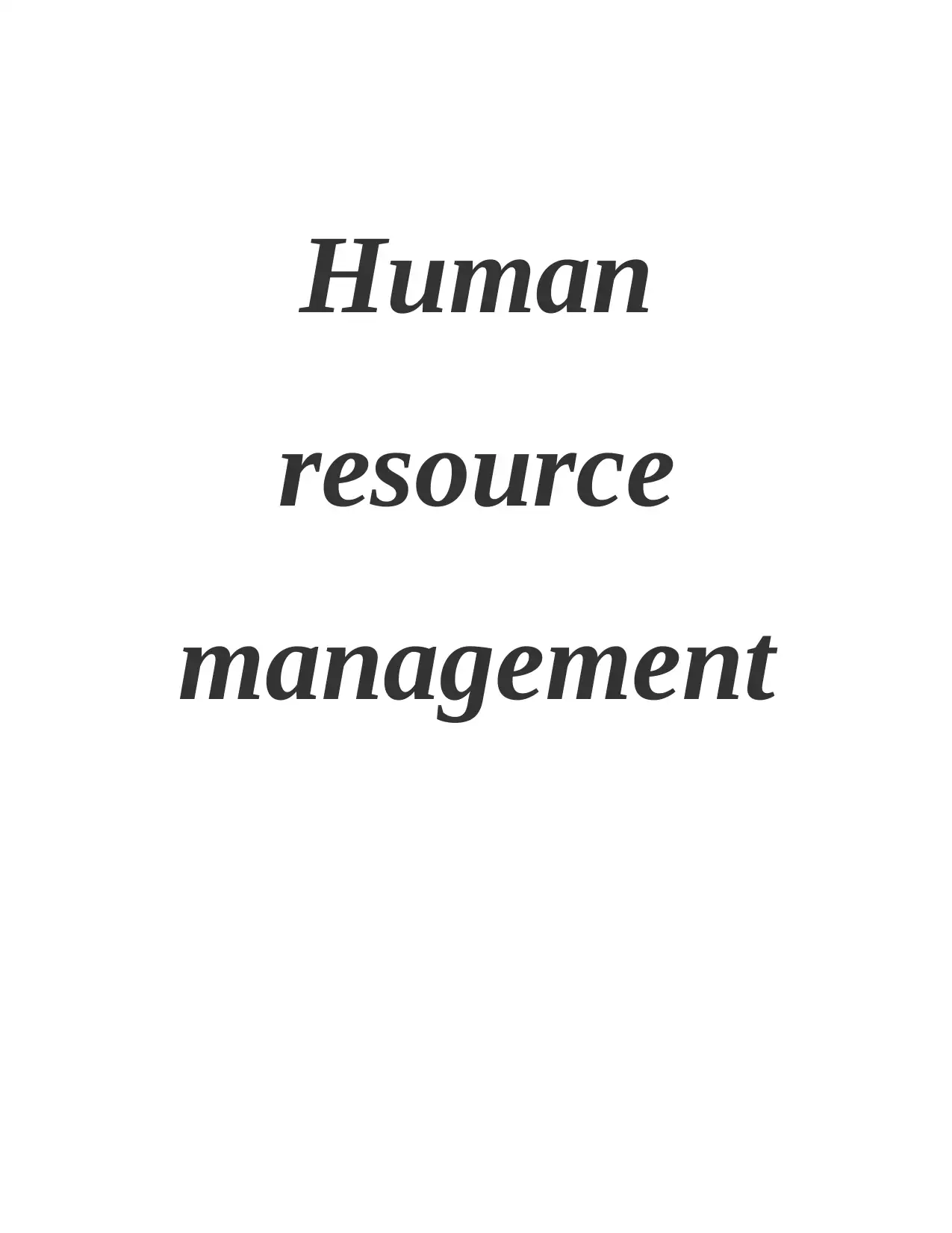
Human
resource
management
resource
management
Paraphrase This Document
Need a fresh take? Get an instant paraphrase of this document with our AI Paraphraser
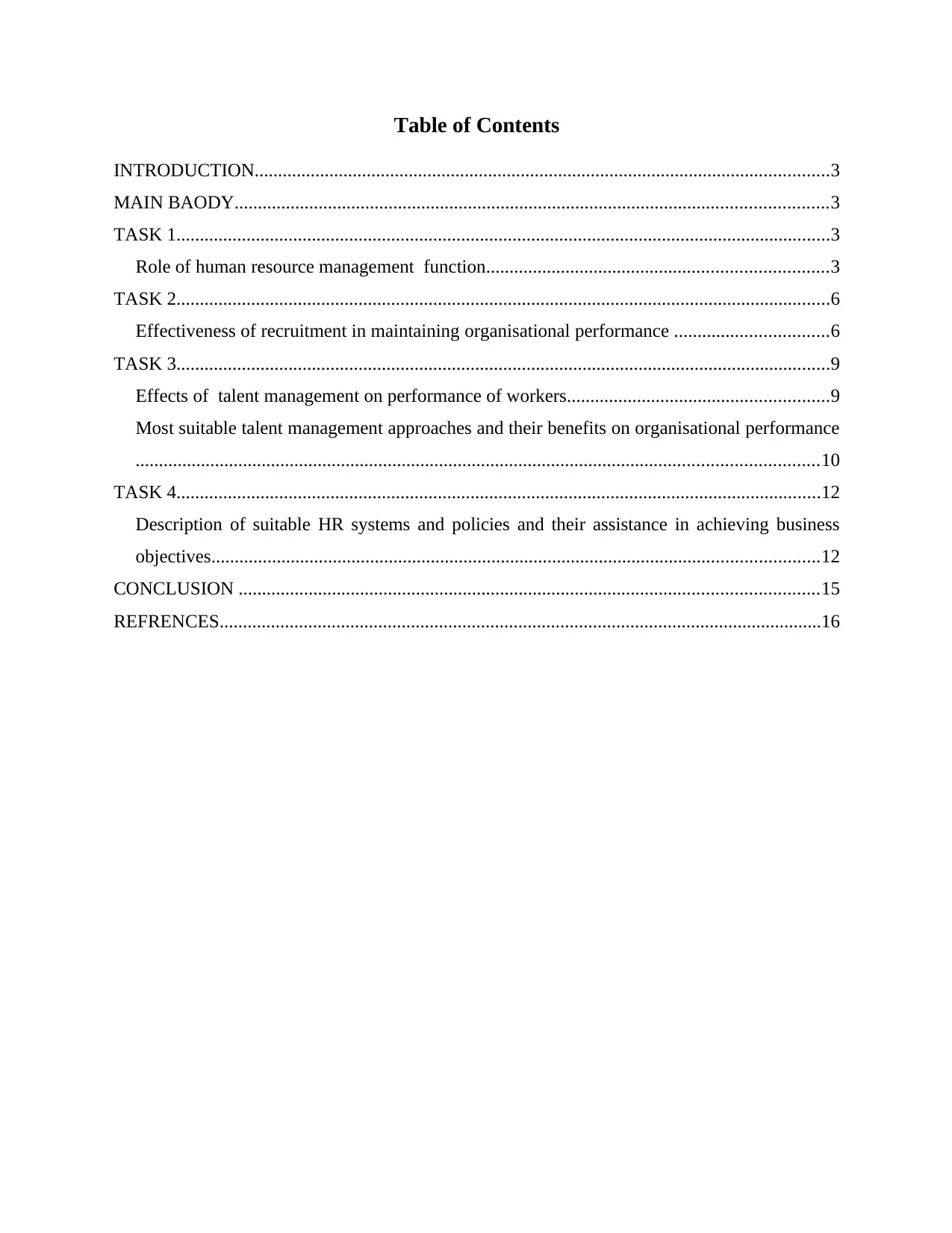
Table of Contents
INTRODUCTION...........................................................................................................................3
MAIN BAODY...............................................................................................................................3
TASK 1............................................................................................................................................3
Role of human resource management function.........................................................................3
TASK 2............................................................................................................................................6
Effectiveness of recruitment in maintaining organisational performance .................................6
TASK 3............................................................................................................................................9
Effects of talent management on performance of workers........................................................9
Most suitable talent management approaches and their benefits on organisational performance
..................................................................................................................................................10
TASK 4..........................................................................................................................................12
Description of suitable HR systems and policies and their assistance in achieving business
objectives..................................................................................................................................12
CONCLUSION ............................................................................................................................15
REFRENCES.................................................................................................................................16
INTRODUCTION...........................................................................................................................3
MAIN BAODY...............................................................................................................................3
TASK 1............................................................................................................................................3
Role of human resource management function.........................................................................3
TASK 2............................................................................................................................................6
Effectiveness of recruitment in maintaining organisational performance .................................6
TASK 3............................................................................................................................................9
Effects of talent management on performance of workers........................................................9
Most suitable talent management approaches and their benefits on organisational performance
..................................................................................................................................................10
TASK 4..........................................................................................................................................12
Description of suitable HR systems and policies and their assistance in achieving business
objectives..................................................................................................................................12
CONCLUSION ............................................................................................................................15
REFRENCES.................................................................................................................................16
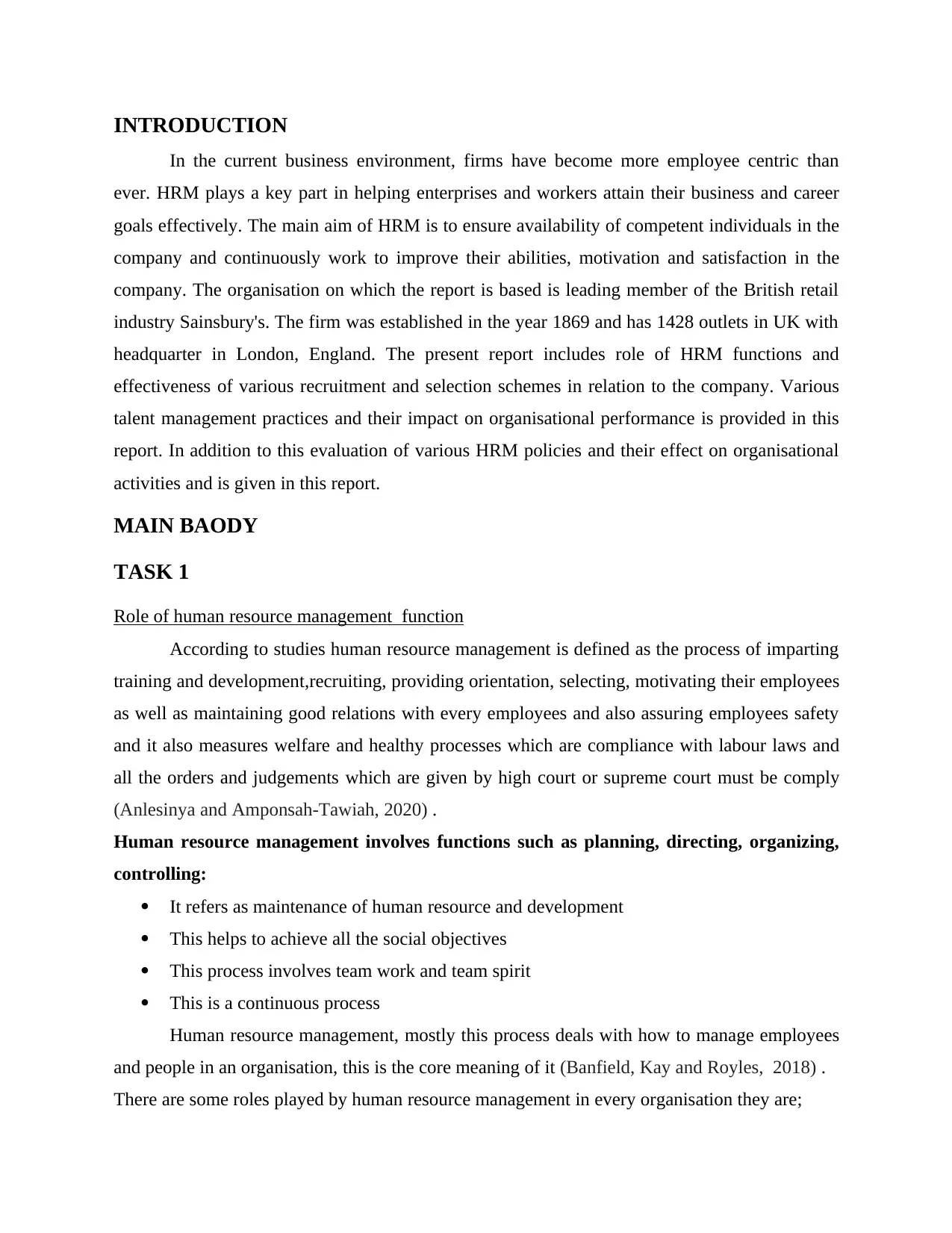
INTRODUCTION
In the current business environment, firms have become more employee centric than
ever. HRM plays a key part in helping enterprises and workers attain their business and career
goals effectively. The main aim of HRM is to ensure availability of competent individuals in the
company and continuously work to improve their abilities, motivation and satisfaction in the
company. The organisation on which the report is based is leading member of the British retail
industry Sainsbury's. The firm was established in the year 1869 and has 1428 outlets in UK with
headquarter in London, England. The present report includes role of HRM functions and
effectiveness of various recruitment and selection schemes in relation to the company. Various
talent management practices and their impact on organisational performance is provided in this
report. In addition to this evaluation of various HRM policies and their effect on organisational
activities and is given in this report.
MAIN BAODY
TASK 1
Role of human resource management function
According to studies human resource management is defined as the process of imparting
training and development,recruiting, providing orientation, selecting, motivating their employees
as well as maintaining good relations with every employees and also assuring employees safety
and it also measures welfare and healthy processes which are compliance with labour laws and
all the orders and judgements which are given by high court or supreme court must be comply
(Anlesinya and Amponsah-Tawiah, 2020) .
Human resource management involves functions such as planning, directing, organizing,
controlling:
It refers as maintenance of human resource and development
This helps to achieve all the social objectives
This process involves team work and team spirit
This is a continuous process
Human resource management, mostly this process deals with how to manage employees
and people in an organisation, this is the core meaning of it (Banfield, Kay and Royles, 2018) .
There are some roles played by human resource management in every organisation they are;
In the current business environment, firms have become more employee centric than
ever. HRM plays a key part in helping enterprises and workers attain their business and career
goals effectively. The main aim of HRM is to ensure availability of competent individuals in the
company and continuously work to improve their abilities, motivation and satisfaction in the
company. The organisation on which the report is based is leading member of the British retail
industry Sainsbury's. The firm was established in the year 1869 and has 1428 outlets in UK with
headquarter in London, England. The present report includes role of HRM functions and
effectiveness of various recruitment and selection schemes in relation to the company. Various
talent management practices and their impact on organisational performance is provided in this
report. In addition to this evaluation of various HRM policies and their effect on organisational
activities and is given in this report.
MAIN BAODY
TASK 1
Role of human resource management function
According to studies human resource management is defined as the process of imparting
training and development,recruiting, providing orientation, selecting, motivating their employees
as well as maintaining good relations with every employees and also assuring employees safety
and it also measures welfare and healthy processes which are compliance with labour laws and
all the orders and judgements which are given by high court or supreme court must be comply
(Anlesinya and Amponsah-Tawiah, 2020) .
Human resource management involves functions such as planning, directing, organizing,
controlling:
It refers as maintenance of human resource and development
This helps to achieve all the social objectives
This process involves team work and team spirit
This is a continuous process
Human resource management, mostly this process deals with how to manage employees
and people in an organisation, this is the core meaning of it (Banfield, Kay and Royles, 2018) .
There are some roles played by human resource management in every organisation they are;
⊘ This is a preview!⊘
Do you want full access?
Subscribe today to unlock all pages.

Trusted by 1+ million students worldwide
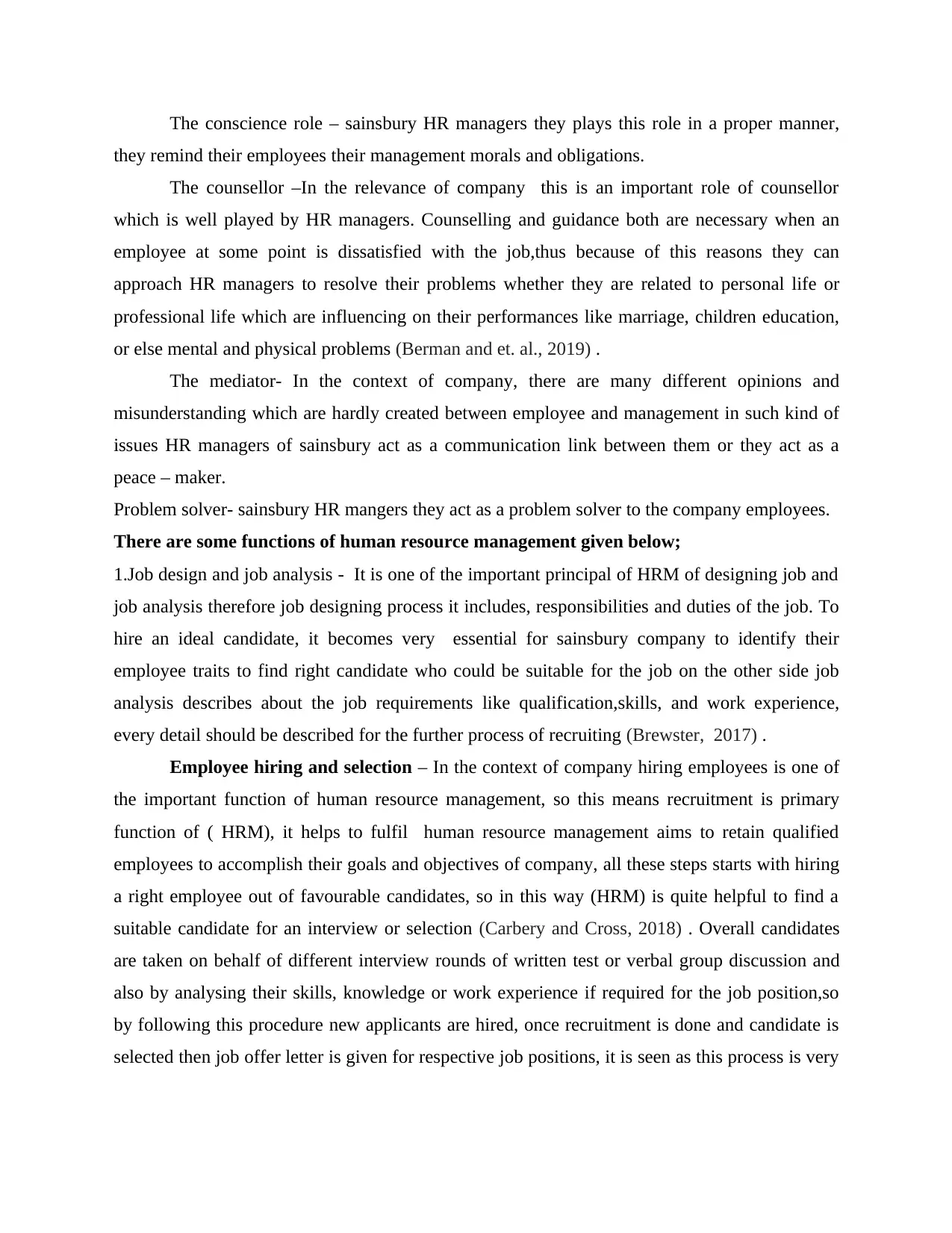
The conscience role – sainsbury HR managers they plays this role in a proper manner,
they remind their employees their management morals and obligations.
The counsellor –In the relevance of company this is an important role of counsellor
which is well played by HR managers. Counselling and guidance both are necessary when an
employee at some point is dissatisfied with the job,thus because of this reasons they can
approach HR managers to resolve their problems whether they are related to personal life or
professional life which are influencing on their performances like marriage, children education,
or else mental and physical problems (Berman and et. al., 2019) .
The mediator- In the context of company, there are many different opinions and
misunderstanding which are hardly created between employee and management in such kind of
issues HR managers of sainsbury act as a communication link between them or they act as a
peace – maker.
Problem solver- sainsbury HR mangers they act as a problem solver to the company employees.
There are some functions of human resource management given below;
1.Job design and job analysis - It is one of the important principal of HRM of designing job and
job analysis therefore job designing process it includes, responsibilities and duties of the job. To
hire an ideal candidate, it becomes very essential for sainsbury company to identify their
employee traits to find right candidate who could be suitable for the job on the other side job
analysis describes about the job requirements like qualification,skills, and work experience,
every detail should be described for the further process of recruiting (Brewster, 2017) .
Employee hiring and selection – In the context of company hiring employees is one of
the important function of human resource management, so this means recruitment is primary
function of ( HRM), it helps to fulfil human resource management aims to retain qualified
employees to accomplish their goals and objectives of company, all these steps starts with hiring
a right employee out of favourable candidates, so in this way (HRM) is quite helpful to find a
suitable candidate for an interview or selection (Carbery and Cross, 2018) . Overall candidates
are taken on behalf of different interview rounds of written test or verbal group discussion and
also by analysing their skills, knowledge or work experience if required for the job position,so
by following this procedure new applicants are hired, once recruitment is done and candidate is
selected then job offer letter is given for respective job positions, it is seen as this process is very
they remind their employees their management morals and obligations.
The counsellor –In the relevance of company this is an important role of counsellor
which is well played by HR managers. Counselling and guidance both are necessary when an
employee at some point is dissatisfied with the job,thus because of this reasons they can
approach HR managers to resolve their problems whether they are related to personal life or
professional life which are influencing on their performances like marriage, children education,
or else mental and physical problems (Berman and et. al., 2019) .
The mediator- In the context of company, there are many different opinions and
misunderstanding which are hardly created between employee and management in such kind of
issues HR managers of sainsbury act as a communication link between them or they act as a
peace – maker.
Problem solver- sainsbury HR mangers they act as a problem solver to the company employees.
There are some functions of human resource management given below;
1.Job design and job analysis - It is one of the important principal of HRM of designing job and
job analysis therefore job designing process it includes, responsibilities and duties of the job. To
hire an ideal candidate, it becomes very essential for sainsbury company to identify their
employee traits to find right candidate who could be suitable for the job on the other side job
analysis describes about the job requirements like qualification,skills, and work experience,
every detail should be described for the further process of recruiting (Brewster, 2017) .
Employee hiring and selection – In the context of company hiring employees is one of
the important function of human resource management, so this means recruitment is primary
function of ( HRM), it helps to fulfil human resource management aims to retain qualified
employees to accomplish their goals and objectives of company, all these steps starts with hiring
a right employee out of favourable candidates, so in this way (HRM) is quite helpful to find a
suitable candidate for an interview or selection (Carbery and Cross, 2018) . Overall candidates
are taken on behalf of different interview rounds of written test or verbal group discussion and
also by analysing their skills, knowledge or work experience if required for the job position,so
by following this procedure new applicants are hired, once recruitment is done and candidate is
selected then job offer letter is given for respective job positions, it is seen as this process is very
Paraphrase This Document
Need a fresh take? Get an instant paraphrase of this document with our AI Paraphraser
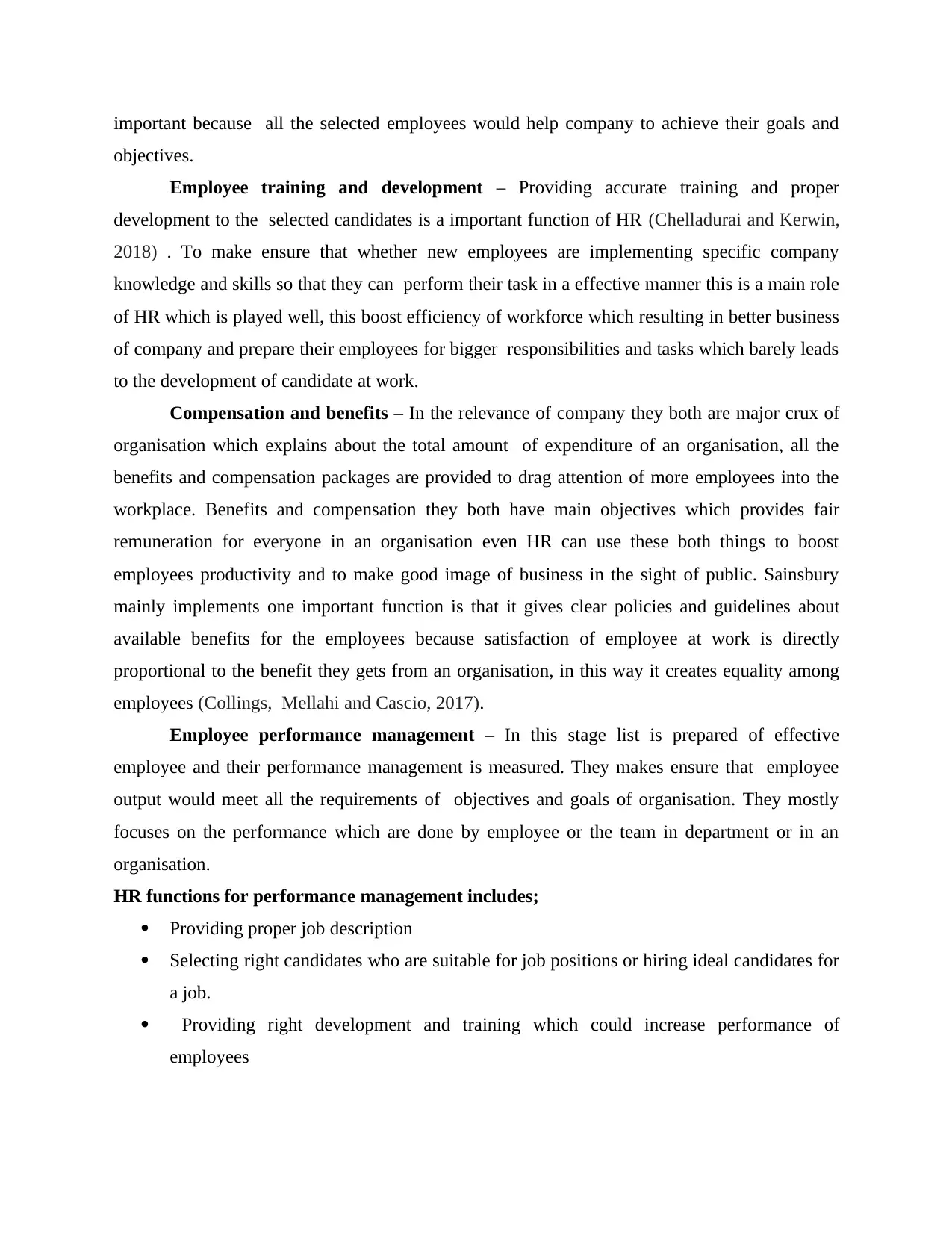
important because all the selected employees would help company to achieve their goals and
objectives.
Employee training and development – Providing accurate training and proper
development to the selected candidates is a important function of HR (Chelladurai and Kerwin,
2018) . To make ensure that whether new employees are implementing specific company
knowledge and skills so that they can perform their task in a effective manner this is a main role
of HR which is played well, this boost efficiency of workforce which resulting in better business
of company and prepare their employees for bigger responsibilities and tasks which barely leads
to the development of candidate at work.
Compensation and benefits – In the relevance of company they both are major crux of
organisation which explains about the total amount of expenditure of an organisation, all the
benefits and compensation packages are provided to drag attention of more employees into the
workplace. Benefits and compensation they both have main objectives which provides fair
remuneration for everyone in an organisation even HR can use these both things to boost
employees productivity and to make good image of business in the sight of public. Sainsbury
mainly implements one important function is that it gives clear policies and guidelines about
available benefits for the employees because satisfaction of employee at work is directly
proportional to the benefit they gets from an organisation, in this way it creates equality among
employees (Collings, Mellahi and Cascio, 2017).
Employee performance management – In this stage list is prepared of effective
employee and their performance management is measured. They makes ensure that employee
output would meet all the requirements of objectives and goals of organisation. They mostly
focuses on the performance which are done by employee or the team in department or in an
organisation.
HR functions for performance management includes;
Providing proper job description
Selecting right candidates who are suitable for job positions or hiring ideal candidates for
a job.
Providing right development and training which could increase performance of
employees
objectives.
Employee training and development – Providing accurate training and proper
development to the selected candidates is a important function of HR (Chelladurai and Kerwin,
2018) . To make ensure that whether new employees are implementing specific company
knowledge and skills so that they can perform their task in a effective manner this is a main role
of HR which is played well, this boost efficiency of workforce which resulting in better business
of company and prepare their employees for bigger responsibilities and tasks which barely leads
to the development of candidate at work.
Compensation and benefits – In the relevance of company they both are major crux of
organisation which explains about the total amount of expenditure of an organisation, all the
benefits and compensation packages are provided to drag attention of more employees into the
workplace. Benefits and compensation they both have main objectives which provides fair
remuneration for everyone in an organisation even HR can use these both things to boost
employees productivity and to make good image of business in the sight of public. Sainsbury
mainly implements one important function is that it gives clear policies and guidelines about
available benefits for the employees because satisfaction of employee at work is directly
proportional to the benefit they gets from an organisation, in this way it creates equality among
employees (Collings, Mellahi and Cascio, 2017).
Employee performance management – In this stage list is prepared of effective
employee and their performance management is measured. They makes ensure that employee
output would meet all the requirements of objectives and goals of organisation. They mostly
focuses on the performance which are done by employee or the team in department or in an
organisation.
HR functions for performance management includes;
Providing proper job description
Selecting right candidates who are suitable for job positions or hiring ideal candidates for
a job.
Providing right development and training which could increase performance of
employees
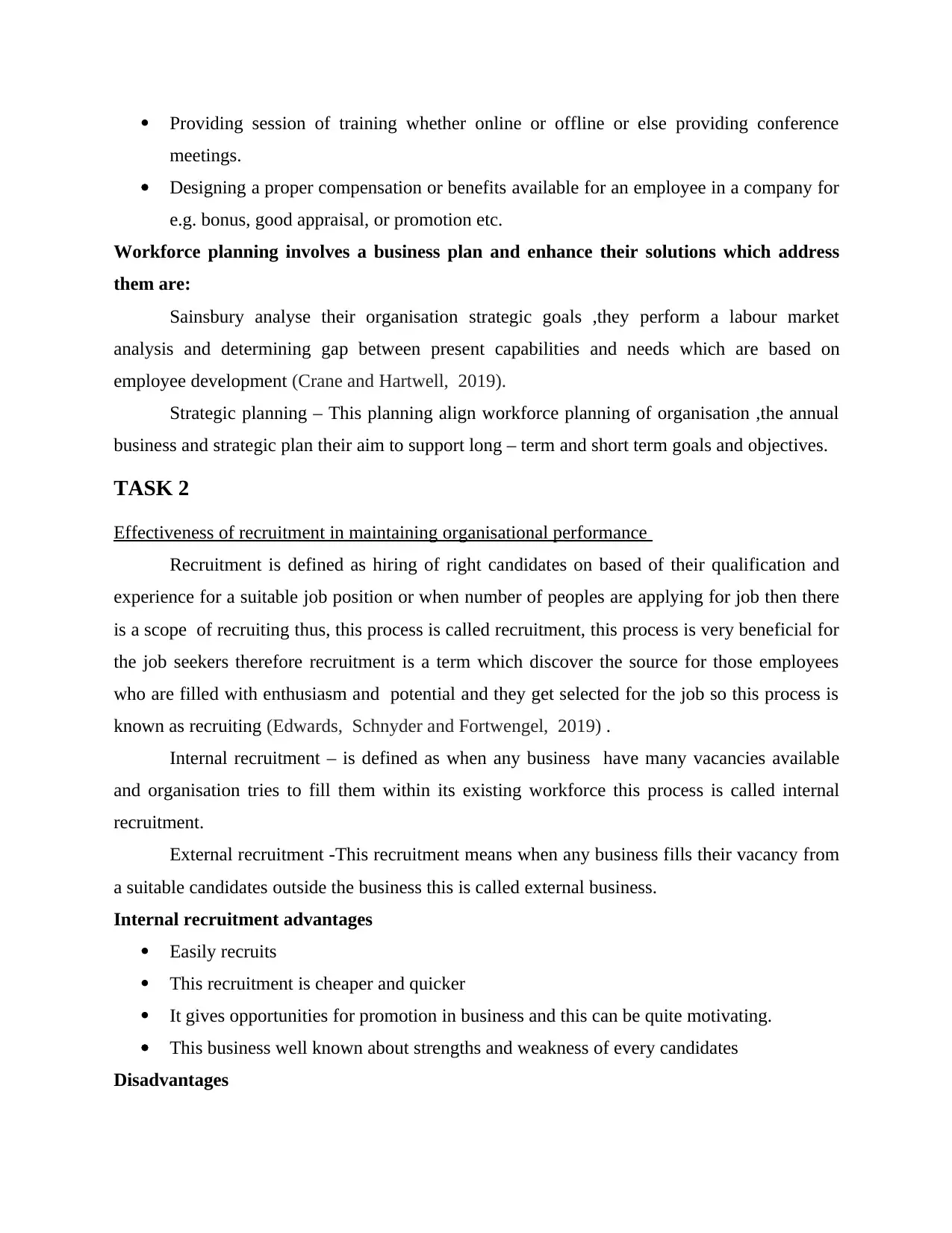
Providing session of training whether online or offline or else providing conference
meetings.
Designing a proper compensation or benefits available for an employee in a company for
e.g. bonus, good appraisal, or promotion etc.
Workforce planning involves a business plan and enhance their solutions which address
them are:
Sainsbury analyse their organisation strategic goals ,they perform a labour market
analysis and determining gap between present capabilities and needs which are based on
employee development (Crane and Hartwell, 2019).
Strategic planning – This planning align workforce planning of organisation ,the annual
business and strategic plan their aim to support long – term and short term goals and objectives.
TASK 2
Effectiveness of recruitment in maintaining organisational performance
Recruitment is defined as hiring of right candidates on based of their qualification and
experience for a suitable job position or when number of peoples are applying for job then there
is a scope of recruiting thus, this process is called recruitment, this process is very beneficial for
the job seekers therefore recruitment is a term which discover the source for those employees
who are filled with enthusiasm and potential and they get selected for the job so this process is
known as recruiting (Edwards, Schnyder and Fortwengel, 2019) .
Internal recruitment – is defined as when any business have many vacancies available
and organisation tries to fill them within its existing workforce this process is called internal
recruitment.
External recruitment -This recruitment means when any business fills their vacancy from
a suitable candidates outside the business this is called external business.
Internal recruitment advantages
Easily recruits
This recruitment is cheaper and quicker
It gives opportunities for promotion in business and this can be quite motivating.
This business well known about strengths and weakness of every candidates
Disadvantages
meetings.
Designing a proper compensation or benefits available for an employee in a company for
e.g. bonus, good appraisal, or promotion etc.
Workforce planning involves a business plan and enhance their solutions which address
them are:
Sainsbury analyse their organisation strategic goals ,they perform a labour market
analysis and determining gap between present capabilities and needs which are based on
employee development (Crane and Hartwell, 2019).
Strategic planning – This planning align workforce planning of organisation ,the annual
business and strategic plan their aim to support long – term and short term goals and objectives.
TASK 2
Effectiveness of recruitment in maintaining organisational performance
Recruitment is defined as hiring of right candidates on based of their qualification and
experience for a suitable job position or when number of peoples are applying for job then there
is a scope of recruiting thus, this process is called recruitment, this process is very beneficial for
the job seekers therefore recruitment is a term which discover the source for those employees
who are filled with enthusiasm and potential and they get selected for the job so this process is
known as recruiting (Edwards, Schnyder and Fortwengel, 2019) .
Internal recruitment – is defined as when any business have many vacancies available
and organisation tries to fill them within its existing workforce this process is called internal
recruitment.
External recruitment -This recruitment means when any business fills their vacancy from
a suitable candidates outside the business this is called external business.
Internal recruitment advantages
Easily recruits
This recruitment is cheaper and quicker
It gives opportunities for promotion in business and this can be quite motivating.
This business well known about strengths and weakness of every candidates
Disadvantages
⊘ This is a preview!⊘
Do you want full access?
Subscribe today to unlock all pages.

Trusted by 1+ million students worldwide
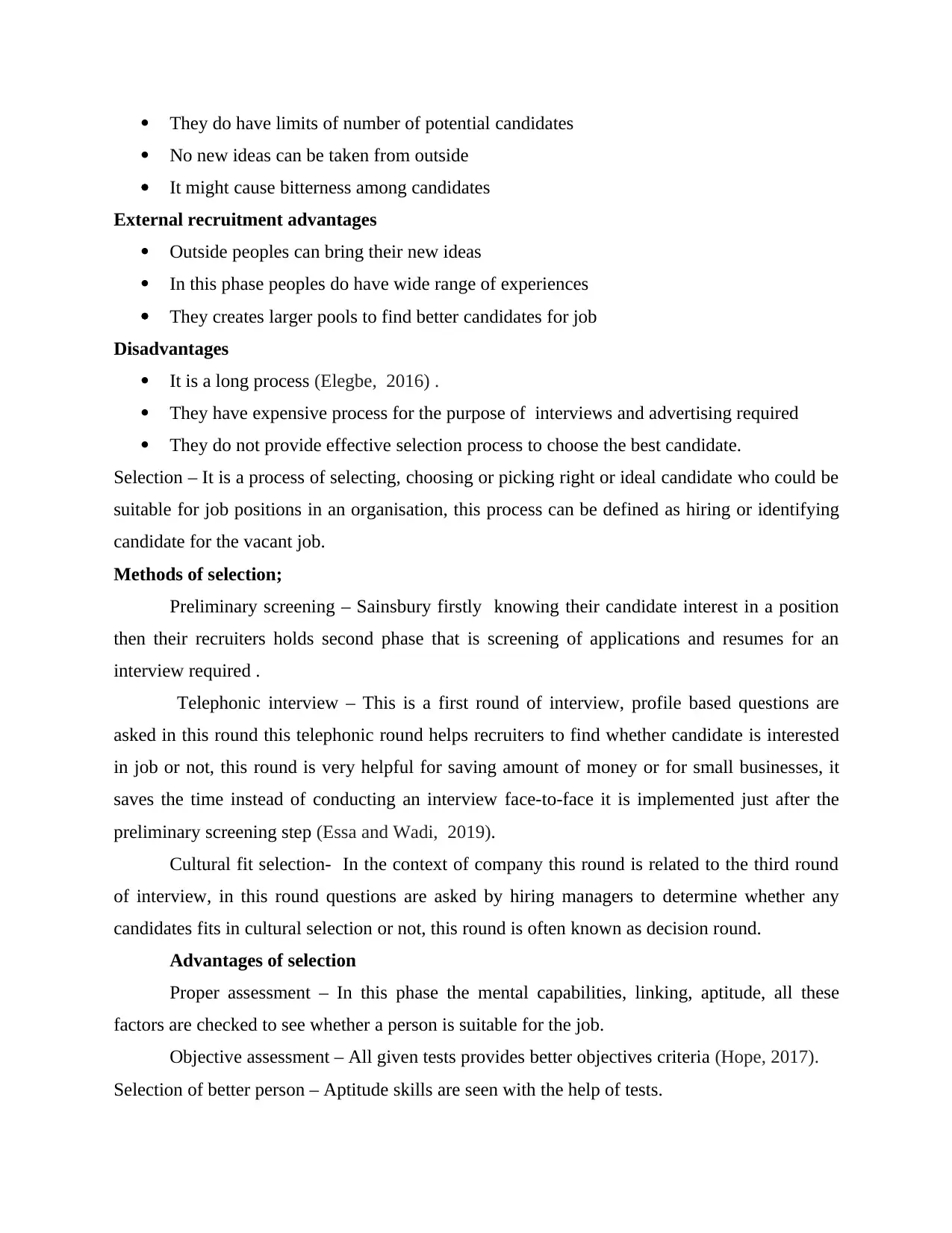
They do have limits of number of potential candidates
No new ideas can be taken from outside
It might cause bitterness among candidates
External recruitment advantages
Outside peoples can bring their new ideas
In this phase peoples do have wide range of experiences
They creates larger pools to find better candidates for job
Disadvantages
It is a long process (Elegbe, 2016) .
They have expensive process for the purpose of interviews and advertising required
They do not provide effective selection process to choose the best candidate.
Selection – It is a process of selecting, choosing or picking right or ideal candidate who could be
suitable for job positions in an organisation, this process can be defined as hiring or identifying
candidate for the vacant job.
Methods of selection;
Preliminary screening – Sainsbury firstly knowing their candidate interest in a position
then their recruiters holds second phase that is screening of applications and resumes for an
interview required .
Telephonic interview – This is a first round of interview, profile based questions are
asked in this round this telephonic round helps recruiters to find whether candidate is interested
in job or not, this round is very helpful for saving amount of money or for small businesses, it
saves the time instead of conducting an interview face-to-face it is implemented just after the
preliminary screening step (Essa and Wadi, 2019).
Cultural fit selection- In the context of company this round is related to the third round
of interview, in this round questions are asked by hiring managers to determine whether any
candidates fits in cultural selection or not, this round is often known as decision round.
Advantages of selection
Proper assessment – In this phase the mental capabilities, linking, aptitude, all these
factors are checked to see whether a person is suitable for the job.
Objective assessment – All given tests provides better objectives criteria (Hope, 2017).
Selection of better person – Aptitude skills are seen with the help of tests.
No new ideas can be taken from outside
It might cause bitterness among candidates
External recruitment advantages
Outside peoples can bring their new ideas
In this phase peoples do have wide range of experiences
They creates larger pools to find better candidates for job
Disadvantages
It is a long process (Elegbe, 2016) .
They have expensive process for the purpose of interviews and advertising required
They do not provide effective selection process to choose the best candidate.
Selection – It is a process of selecting, choosing or picking right or ideal candidate who could be
suitable for job positions in an organisation, this process can be defined as hiring or identifying
candidate for the vacant job.
Methods of selection;
Preliminary screening – Sainsbury firstly knowing their candidate interest in a position
then their recruiters holds second phase that is screening of applications and resumes for an
interview required .
Telephonic interview – This is a first round of interview, profile based questions are
asked in this round this telephonic round helps recruiters to find whether candidate is interested
in job or not, this round is very helpful for saving amount of money or for small businesses, it
saves the time instead of conducting an interview face-to-face it is implemented just after the
preliminary screening step (Essa and Wadi, 2019).
Cultural fit selection- In the context of company this round is related to the third round
of interview, in this round questions are asked by hiring managers to determine whether any
candidates fits in cultural selection or not, this round is often known as decision round.
Advantages of selection
Proper assessment – In this phase the mental capabilities, linking, aptitude, all these
factors are checked to see whether a person is suitable for the job.
Objective assessment – All given tests provides better objectives criteria (Hope, 2017).
Selection of better person – Aptitude skills are seen with the help of tests.
Paraphrase This Document
Need a fresh take? Get an instant paraphrase of this document with our AI Paraphraser
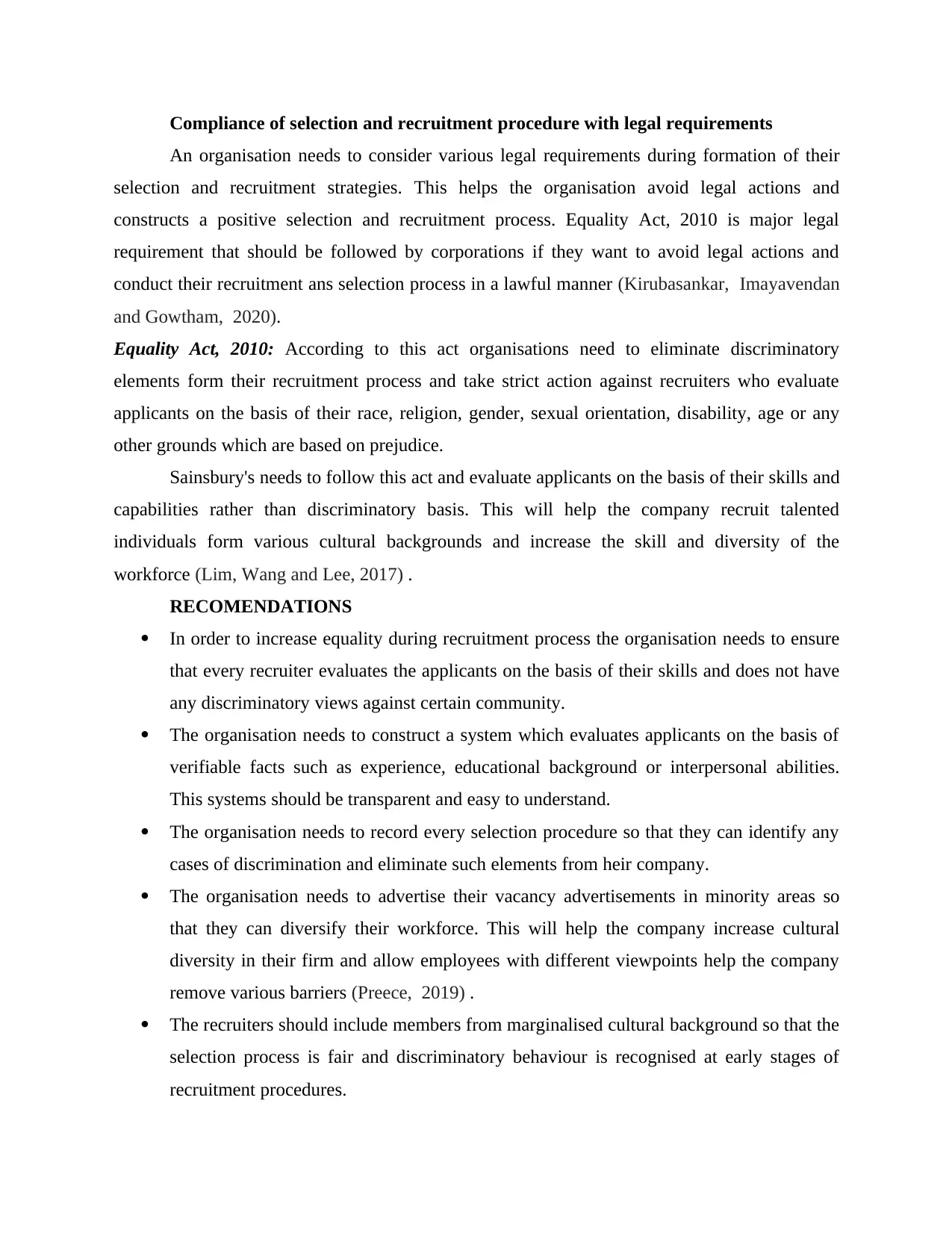
Compliance of selection and recruitment procedure with legal requirements
An organisation needs to consider various legal requirements during formation of their
selection and recruitment strategies. This helps the organisation avoid legal actions and
constructs a positive selection and recruitment process. Equality Act, 2010 is major legal
requirement that should be followed by corporations if they want to avoid legal actions and
conduct their recruitment ans selection process in a lawful manner (Kirubasankar, Imayavendan
and Gowtham, 2020).
Equality Act, 2010: According to this act organisations need to eliminate discriminatory
elements form their recruitment process and take strict action against recruiters who evaluate
applicants on the basis of their race, religion, gender, sexual orientation, disability, age or any
other grounds which are based on prejudice.
Sainsbury's needs to follow this act and evaluate applicants on the basis of their skills and
capabilities rather than discriminatory basis. This will help the company recruit talented
individuals form various cultural backgrounds and increase the skill and diversity of the
workforce (Lim, Wang and Lee, 2017) .
RECOMENDATIONS
In order to increase equality during recruitment process the organisation needs to ensure
that every recruiter evaluates the applicants on the basis of their skills and does not have
any discriminatory views against certain community.
The organisation needs to construct a system which evaluates applicants on the basis of
verifiable facts such as experience, educational background or interpersonal abilities.
This systems should be transparent and easy to understand.
The organisation needs to record every selection procedure so that they can identify any
cases of discrimination and eliminate such elements from heir company.
The organisation needs to advertise their vacancy advertisements in minority areas so
that they can diversify their workforce. This will help the company increase cultural
diversity in their firm and allow employees with different viewpoints help the company
remove various barriers (Preece, 2019) .
The recruiters should include members from marginalised cultural background so that the
selection process is fair and discriminatory behaviour is recognised at early stages of
recruitment procedures.
An organisation needs to consider various legal requirements during formation of their
selection and recruitment strategies. This helps the organisation avoid legal actions and
constructs a positive selection and recruitment process. Equality Act, 2010 is major legal
requirement that should be followed by corporations if they want to avoid legal actions and
conduct their recruitment ans selection process in a lawful manner (Kirubasankar, Imayavendan
and Gowtham, 2020).
Equality Act, 2010: According to this act organisations need to eliminate discriminatory
elements form their recruitment process and take strict action against recruiters who evaluate
applicants on the basis of their race, religion, gender, sexual orientation, disability, age or any
other grounds which are based on prejudice.
Sainsbury's needs to follow this act and evaluate applicants on the basis of their skills and
capabilities rather than discriminatory basis. This will help the company recruit talented
individuals form various cultural backgrounds and increase the skill and diversity of the
workforce (Lim, Wang and Lee, 2017) .
RECOMENDATIONS
In order to increase equality during recruitment process the organisation needs to ensure
that every recruiter evaluates the applicants on the basis of their skills and does not have
any discriminatory views against certain community.
The organisation needs to construct a system which evaluates applicants on the basis of
verifiable facts such as experience, educational background or interpersonal abilities.
This systems should be transparent and easy to understand.
The organisation needs to record every selection procedure so that they can identify any
cases of discrimination and eliminate such elements from heir company.
The organisation needs to advertise their vacancy advertisements in minority areas so
that they can diversify their workforce. This will help the company increase cultural
diversity in their firm and allow employees with different viewpoints help the company
remove various barriers (Preece, 2019) .
The recruiters should include members from marginalised cultural background so that the
selection process is fair and discriminatory behaviour is recognised at early stages of
recruitment procedures.
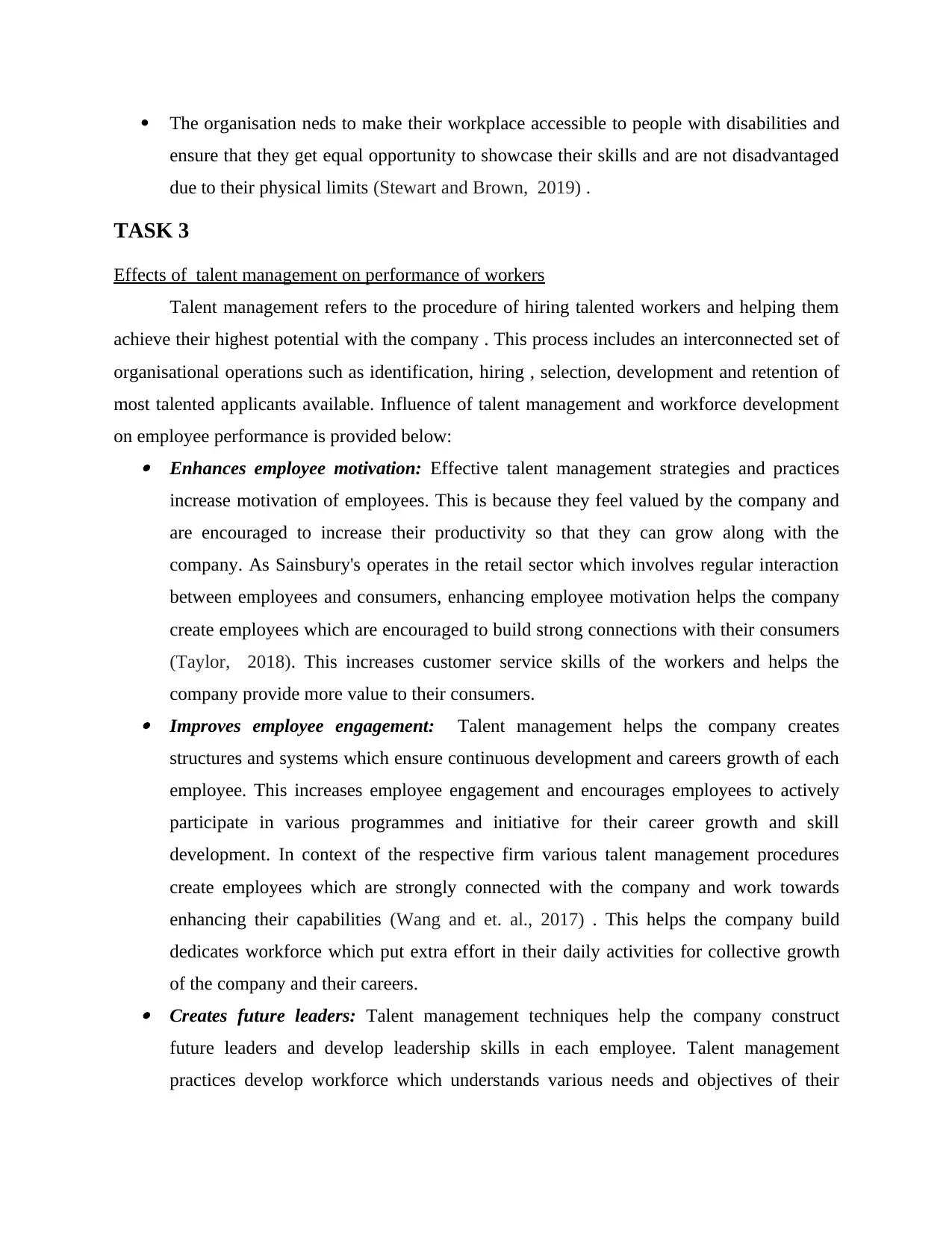
The organisation neds to make their workplace accessible to people with disabilities and
ensure that they get equal opportunity to showcase their skills and are not disadvantaged
due to their physical limits (Stewart and Brown, 2019) .
TASK 3
Effects of talent management on performance of workers
Talent management refers to the procedure of hiring talented workers and helping them
achieve their highest potential with the company . This process includes an interconnected set of
organisational operations such as identification, hiring , selection, development and retention of
most talented applicants available. Influence of talent management and workforce development
on employee performance is provided below: Enhances employee motivation: Effective talent management strategies and practices
increase motivation of employees. This is because they feel valued by the company and
are encouraged to increase their productivity so that they can grow along with the
company. As Sainsbury's operates in the retail sector which involves regular interaction
between employees and consumers, enhancing employee motivation helps the company
create employees which are encouraged to build strong connections with their consumers
(Taylor, 2018). This increases customer service skills of the workers and helps the
company provide more value to their consumers. Improves employee engagement: Talent management helps the company creates
structures and systems which ensure continuous development and careers growth of each
employee. This increases employee engagement and encourages employees to actively
participate in various programmes and initiative for their career growth and skill
development. In context of the respective firm various talent management procedures
create employees which are strongly connected with the company and work towards
enhancing their capabilities (Wang and et. al., 2017) . This helps the company build
dedicates workforce which put extra effort in their daily activities for collective growth
of the company and their careers. Creates future leaders: Talent management techniques help the company construct
future leaders and develop leadership skills in each employee. Talent management
practices develop workforce which understands various needs and objectives of their
ensure that they get equal opportunity to showcase their skills and are not disadvantaged
due to their physical limits (Stewart and Brown, 2019) .
TASK 3
Effects of talent management on performance of workers
Talent management refers to the procedure of hiring talented workers and helping them
achieve their highest potential with the company . This process includes an interconnected set of
organisational operations such as identification, hiring , selection, development and retention of
most talented applicants available. Influence of talent management and workforce development
on employee performance is provided below: Enhances employee motivation: Effective talent management strategies and practices
increase motivation of employees. This is because they feel valued by the company and
are encouraged to increase their productivity so that they can grow along with the
company. As Sainsbury's operates in the retail sector which involves regular interaction
between employees and consumers, enhancing employee motivation helps the company
create employees which are encouraged to build strong connections with their consumers
(Taylor, 2018). This increases customer service skills of the workers and helps the
company provide more value to their consumers. Improves employee engagement: Talent management helps the company creates
structures and systems which ensure continuous development and careers growth of each
employee. This increases employee engagement and encourages employees to actively
participate in various programmes and initiative for their career growth and skill
development. In context of the respective firm various talent management procedures
create employees which are strongly connected with the company and work towards
enhancing their capabilities (Wang and et. al., 2017) . This helps the company build
dedicates workforce which put extra effort in their daily activities for collective growth
of the company and their careers. Creates future leaders: Talent management techniques help the company construct
future leaders and develop leadership skills in each employee. Talent management
practices develop workforce which understands various needs and objectives of their
⊘ This is a preview!⊘
Do you want full access?
Subscribe today to unlock all pages.

Trusted by 1+ million students worldwide
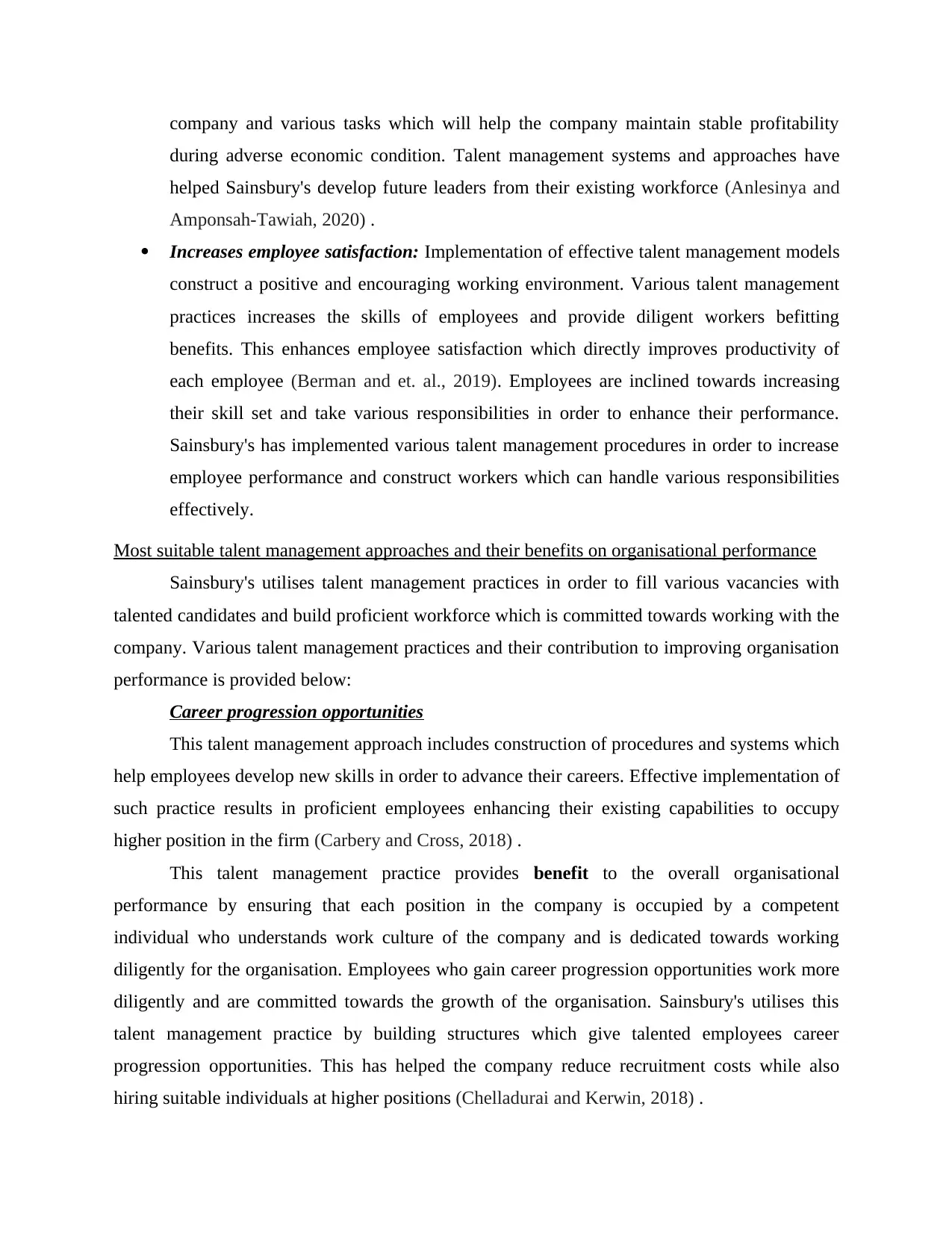
company and various tasks which will help the company maintain stable profitability
during adverse economic condition. Talent management systems and approaches have
helped Sainsbury's develop future leaders from their existing workforce (Anlesinya and
Amponsah-Tawiah, 2020) .
Increases employee satisfaction: Implementation of effective talent management models
construct a positive and encouraging working environment. Various talent management
practices increases the skills of employees and provide diligent workers befitting
benefits. This enhances employee satisfaction which directly improves productivity of
each employee (Berman and et. al., 2019). Employees are inclined towards increasing
their skill set and take various responsibilities in order to enhance their performance.
Sainsbury's has implemented various talent management procedures in order to increase
employee performance and construct workers which can handle various responsibilities
effectively.
Most suitable talent management approaches and their benefits on organisational performance
Sainsbury's utilises talent management practices in order to fill various vacancies with
talented candidates and build proficient workforce which is committed towards working with the
company. Various talent management practices and their contribution to improving organisation
performance is provided below:
Career progression opportunities
This talent management approach includes construction of procedures and systems which
help employees develop new skills in order to advance their careers. Effective implementation of
such practice results in proficient employees enhancing their existing capabilities to occupy
higher position in the firm (Carbery and Cross, 2018) .
This talent management practice provides benefit to the overall organisational
performance by ensuring that each position in the company is occupied by a competent
individual who understands work culture of the company and is dedicated towards working
diligently for the organisation. Employees who gain career progression opportunities work more
diligently and are committed towards the growth of the organisation. Sainsbury's utilises this
talent management practice by building structures which give talented employees career
progression opportunities. This has helped the company reduce recruitment costs while also
hiring suitable individuals at higher positions (Chelladurai and Kerwin, 2018) .
during adverse economic condition. Talent management systems and approaches have
helped Sainsbury's develop future leaders from their existing workforce (Anlesinya and
Amponsah-Tawiah, 2020) .
Increases employee satisfaction: Implementation of effective talent management models
construct a positive and encouraging working environment. Various talent management
practices increases the skills of employees and provide diligent workers befitting
benefits. This enhances employee satisfaction which directly improves productivity of
each employee (Berman and et. al., 2019). Employees are inclined towards increasing
their skill set and take various responsibilities in order to enhance their performance.
Sainsbury's has implemented various talent management procedures in order to increase
employee performance and construct workers which can handle various responsibilities
effectively.
Most suitable talent management approaches and their benefits on organisational performance
Sainsbury's utilises talent management practices in order to fill various vacancies with
talented candidates and build proficient workforce which is committed towards working with the
company. Various talent management practices and their contribution to improving organisation
performance is provided below:
Career progression opportunities
This talent management approach includes construction of procedures and systems which
help employees develop new skills in order to advance their careers. Effective implementation of
such practice results in proficient employees enhancing their existing capabilities to occupy
higher position in the firm (Carbery and Cross, 2018) .
This talent management practice provides benefit to the overall organisational
performance by ensuring that each position in the company is occupied by a competent
individual who understands work culture of the company and is dedicated towards working
diligently for the organisation. Employees who gain career progression opportunities work more
diligently and are committed towards the growth of the organisation. Sainsbury's utilises this
talent management practice by building structures which give talented employees career
progression opportunities. This has helped the company reduce recruitment costs while also
hiring suitable individuals at higher positions (Chelladurai and Kerwin, 2018) .
Paraphrase This Document
Need a fresh take? Get an instant paraphrase of this document with our AI Paraphraser
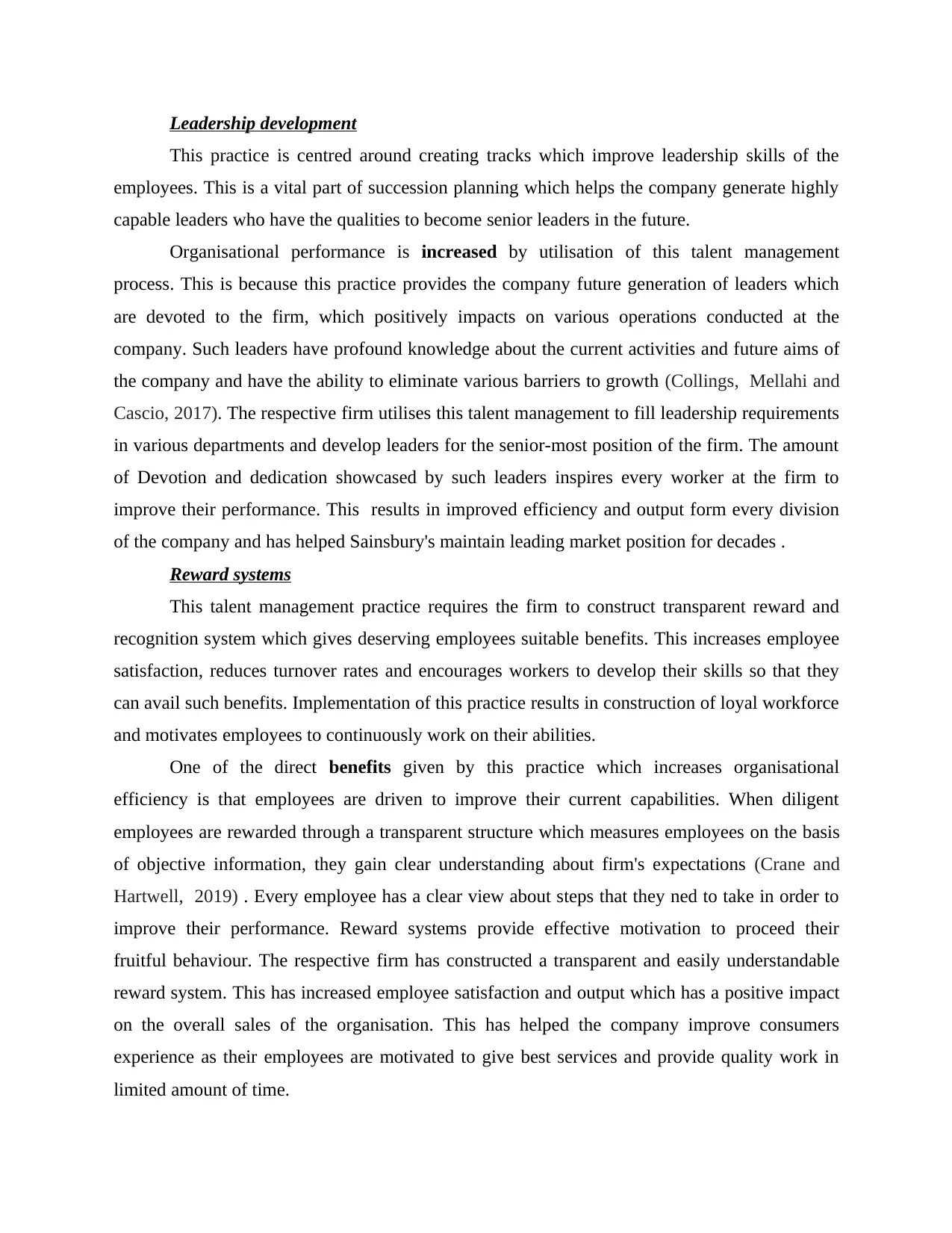
Leadership development
This practice is centred around creating tracks which improve leadership skills of the
employees. This is a vital part of succession planning which helps the company generate highly
capable leaders who have the qualities to become senior leaders in the future.
Organisational performance is increased by utilisation of this talent management
process. This is because this practice provides the company future generation of leaders which
are devoted to the firm, which positively impacts on various operations conducted at the
company. Such leaders have profound knowledge about the current activities and future aims of
the company and have the ability to eliminate various barriers to growth (Collings, Mellahi and
Cascio, 2017). The respective firm utilises this talent management to fill leadership requirements
in various departments and develop leaders for the senior-most position of the firm. The amount
of Devotion and dedication showcased by such leaders inspires every worker at the firm to
improve their performance. This results in improved efficiency and output form every division
of the company and has helped Sainsbury's maintain leading market position for decades .
Reward systems
This talent management practice requires the firm to construct transparent reward and
recognition system which gives deserving employees suitable benefits. This increases employee
satisfaction, reduces turnover rates and encourages workers to develop their skills so that they
can avail such benefits. Implementation of this practice results in construction of loyal workforce
and motivates employees to continuously work on their abilities.
One of the direct benefits given by this practice which increases organisational
efficiency is that employees are driven to improve their current capabilities. When diligent
employees are rewarded through a transparent structure which measures employees on the basis
of objective information, they gain clear understanding about firm's expectations (Crane and
Hartwell, 2019) . Every employee has a clear view about steps that they ned to take in order to
improve their performance. Reward systems provide effective motivation to proceed their
fruitful behaviour. The respective firm has constructed a transparent and easily understandable
reward system. This has increased employee satisfaction and output which has a positive impact
on the overall sales of the organisation. This has helped the company improve consumers
experience as their employees are motivated to give best services and provide quality work in
limited amount of time.
This practice is centred around creating tracks which improve leadership skills of the
employees. This is a vital part of succession planning which helps the company generate highly
capable leaders who have the qualities to become senior leaders in the future.
Organisational performance is increased by utilisation of this talent management
process. This is because this practice provides the company future generation of leaders which
are devoted to the firm, which positively impacts on various operations conducted at the
company. Such leaders have profound knowledge about the current activities and future aims of
the company and have the ability to eliminate various barriers to growth (Collings, Mellahi and
Cascio, 2017). The respective firm utilises this talent management to fill leadership requirements
in various departments and develop leaders for the senior-most position of the firm. The amount
of Devotion and dedication showcased by such leaders inspires every worker at the firm to
improve their performance. This results in improved efficiency and output form every division
of the company and has helped Sainsbury's maintain leading market position for decades .
Reward systems
This talent management practice requires the firm to construct transparent reward and
recognition system which gives deserving employees suitable benefits. This increases employee
satisfaction, reduces turnover rates and encourages workers to develop their skills so that they
can avail such benefits. Implementation of this practice results in construction of loyal workforce
and motivates employees to continuously work on their abilities.
One of the direct benefits given by this practice which increases organisational
efficiency is that employees are driven to improve their current capabilities. When diligent
employees are rewarded through a transparent structure which measures employees on the basis
of objective information, they gain clear understanding about firm's expectations (Crane and
Hartwell, 2019) . Every employee has a clear view about steps that they ned to take in order to
improve their performance. Reward systems provide effective motivation to proceed their
fruitful behaviour. The respective firm has constructed a transparent and easily understandable
reward system. This has increased employee satisfaction and output which has a positive impact
on the overall sales of the organisation. This has helped the company improve consumers
experience as their employees are motivated to give best services and provide quality work in
limited amount of time.
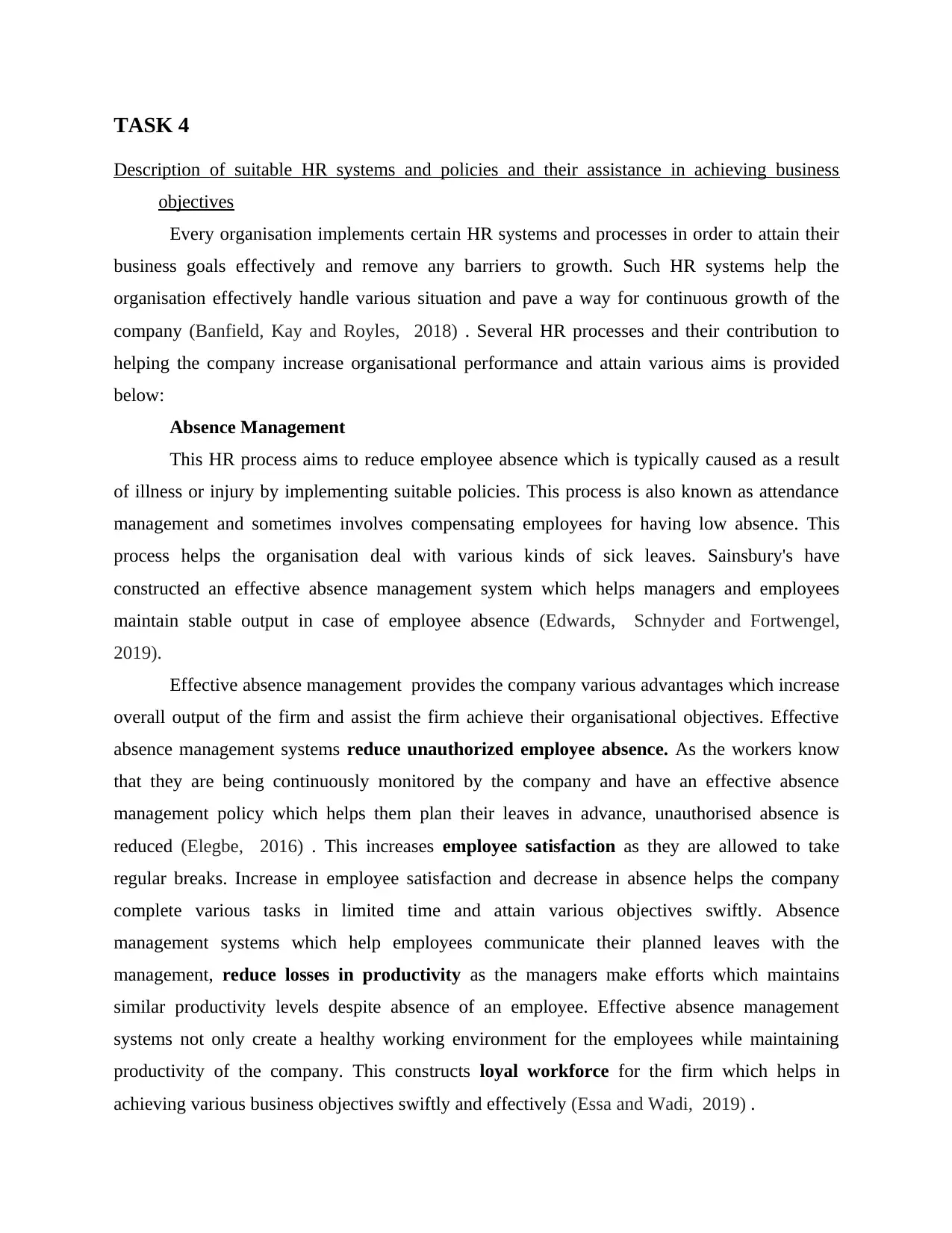
TASK 4
Description of suitable HR systems and policies and their assistance in achieving business
objectives
Every organisation implements certain HR systems and processes in order to attain their
business goals effectively and remove any barriers to growth. Such HR systems help the
organisation effectively handle various situation and pave a way for continuous growth of the
company (Banfield, Kay and Royles, 2018) . Several HR processes and their contribution to
helping the company increase organisational performance and attain various aims is provided
below:
Absence Management
This HR process aims to reduce employee absence which is typically caused as a result
of illness or injury by implementing suitable policies. This process is also known as attendance
management and sometimes involves compensating employees for having low absence. This
process helps the organisation deal with various kinds of sick leaves. Sainsbury's have
constructed an effective absence management system which helps managers and employees
maintain stable output in case of employee absence (Edwards, Schnyder and Fortwengel,
2019).
Effective absence management provides the company various advantages which increase
overall output of the firm and assist the firm achieve their organisational objectives. Effective
absence management systems reduce unauthorized employee absence. As the workers know
that they are being continuously monitored by the company and have an effective absence
management policy which helps them plan their leaves in advance, unauthorised absence is
reduced (Elegbe, 2016) . This increases employee satisfaction as they are allowed to take
regular breaks. Increase in employee satisfaction and decrease in absence helps the company
complete various tasks in limited time and attain various objectives swiftly. Absence
management systems which help employees communicate their planned leaves with the
management, reduce losses in productivity as the managers make efforts which maintains
similar productivity levels despite absence of an employee. Effective absence management
systems not only create a healthy working environment for the employees while maintaining
productivity of the company. This constructs loyal workforce for the firm which helps in
achieving various business objectives swiftly and effectively (Essa and Wadi, 2019) .
Description of suitable HR systems and policies and their assistance in achieving business
objectives
Every organisation implements certain HR systems and processes in order to attain their
business goals effectively and remove any barriers to growth. Such HR systems help the
organisation effectively handle various situation and pave a way for continuous growth of the
company (Banfield, Kay and Royles, 2018) . Several HR processes and their contribution to
helping the company increase organisational performance and attain various aims is provided
below:
Absence Management
This HR process aims to reduce employee absence which is typically caused as a result
of illness or injury by implementing suitable policies. This process is also known as attendance
management and sometimes involves compensating employees for having low absence. This
process helps the organisation deal with various kinds of sick leaves. Sainsbury's have
constructed an effective absence management system which helps managers and employees
maintain stable output in case of employee absence (Edwards, Schnyder and Fortwengel,
2019).
Effective absence management provides the company various advantages which increase
overall output of the firm and assist the firm achieve their organisational objectives. Effective
absence management systems reduce unauthorized employee absence. As the workers know
that they are being continuously monitored by the company and have an effective absence
management policy which helps them plan their leaves in advance, unauthorised absence is
reduced (Elegbe, 2016) . This increases employee satisfaction as they are allowed to take
regular breaks. Increase in employee satisfaction and decrease in absence helps the company
complete various tasks in limited time and attain various objectives swiftly. Absence
management systems which help employees communicate their planned leaves with the
management, reduce losses in productivity as the managers make efforts which maintains
similar productivity levels despite absence of an employee. Effective absence management
systems not only create a healthy working environment for the employees while maintaining
productivity of the company. This constructs loyal workforce for the firm which helps in
achieving various business objectives swiftly and effectively (Essa and Wadi, 2019) .
⊘ This is a preview!⊘
Do you want full access?
Subscribe today to unlock all pages.

Trusted by 1+ million students worldwide
1 out of 17
Related Documents
Your All-in-One AI-Powered Toolkit for Academic Success.
+13062052269
info@desklib.com
Available 24*7 on WhatsApp / Email
![[object Object]](/_next/static/media/star-bottom.7253800d.svg)
Unlock your academic potential
Copyright © 2020–2025 A2Z Services. All Rights Reserved. Developed and managed by ZUCOL.




